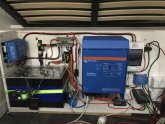New to this so bare with me. I am planning to build my own caravan.
After watching too many videos etc I am of the belief that the sweet spot for maintaining your lithium batteries is to keep them charged between 20% to 90% of their capacity. Don’t fully charge them unless you have to and don’t float them. Similarly don’t drain them.
So after watching one of Will’s videos where he mentions this briefly and talks about setting the maximum charge rate of your solar controller to 13.5 volts so that the battery is only charged to 90% of it’s capacity it got me thinking about my other charging sources.
1. AC Victron Charger 30 amps
2. DC to DC charger - Alternator (50 amps)
3. DC to DC charger - MPPT Solar (50 amps)
These are in addition to a Victron 100/50 solar controller that I can set as Will suggested.
I also plan to fit a Victron BMV-712 unit which allows me to set alarms to activate the relay function. This could be set for 13.5 volts (Battery) to activate and also say for 13 volts to reset.
What I am considering, or asking advice on is the possibility of placing a relay (80 amp) on the positive line of each of the 3 other charging options. In the case of the DC to DC unit the relays would be before the unit itself on the positive lines. With the AC charger the relay would be on the positive cable before the battery.
These relays would be normally closed so that they are essentially in the on position and the circuit is completed. When the alarm goes off on the BMV-712 for the battery voltage reaching 13.5 volts the relays would be activated open8ng the circuit and preventing any further charging of the battery, till the reset voltage is reached.
I don’t think the BMV-712 would push out enough power to run 3 relays simultaneously so there is probably a need for a 4th relay (normally open) which would then power the other relays when activated. The 3 big relays could be wired in parallel.
In this way I would hope to effectively have a set and forget system where the batteries are never charged past a voltage level you set. I can plug my external AC in and the AC battery charger will only be on if the batteries are 13.2volts or below. It will be disconnected at 13.5 volts so will never get to float. Relays are also much cheaper than a Victron Battery Protect or Battery Isolators. That hopefully achieves 1 end of the scale and the relays shouldn’t pull too much power.
I do understand that if wired this way that even on the sunniest day or while plugged 8nto AC that 12volt gear will always be drawing from the battery when the voltage is within the range I have speci
The 20% is achieved by having a Victron BatteryProtect fitted near the battery, or some other low voltage disconnect system.
Does this make sense or more importantly would it work?
Thanks
Laurie




